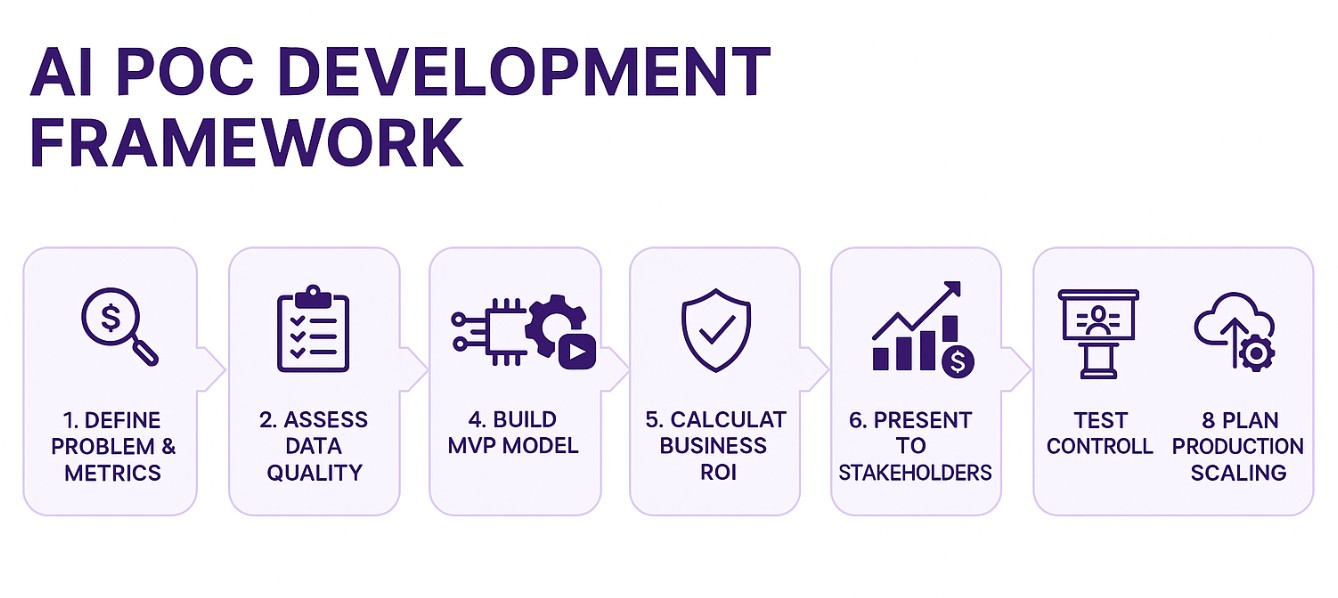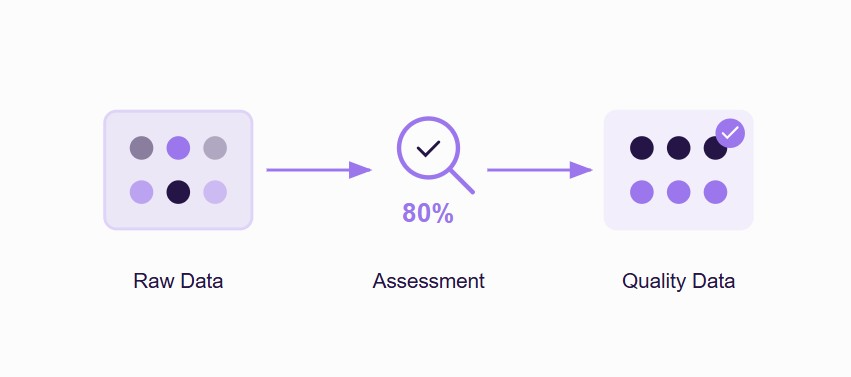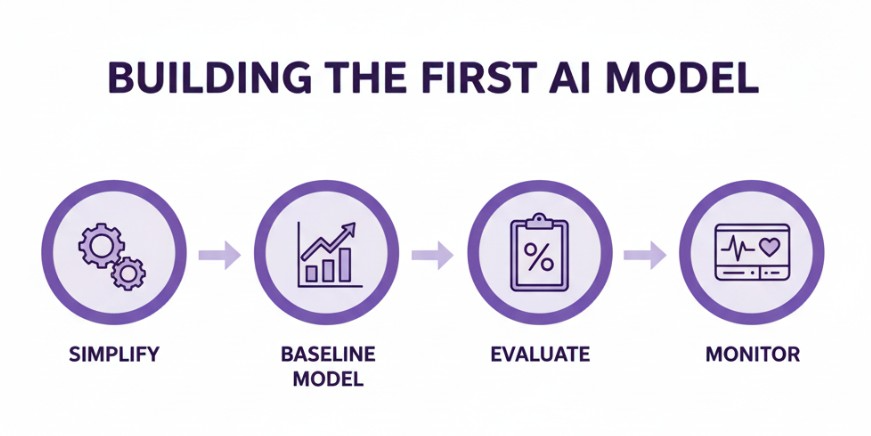AI projects often sound promising on paper, but collapse once they hit real-world conditions. The reason is rarely the technology; it’s the lack of clear proof that an idea works in practice.
Learning how to create an effective proof of concept with AI helps teams separate hype from value and gives leaders the confidence to move forward with impact.
In this article, we will:
- Walk through 8 steps to build a successful ai poc
- Highlight key mistakes that keep AI POCs from production
AI proof of concept development: Complete 8-step framework for success
Building an effective AI proof of concept requires a structured methodology that balances technical feasibility with business value. Most organizations fail because they skip critical planning steps or rush into development without clear objectives.
Here's the proven framework that transforms AI concepts into production-ready solutions:

Step 1: Define your business problem and success metrics
Start with a crystal-clear problem definition before touching any technology. Your AI solution needs to solve a specific, measurable business challenge that directly impacts your bottom line.
What to do:
- Write a one-page problem statement answering: "What specific business challenge costs us $X annually?"
- Document current baseline metrics (processing time, error rates, costs, customer satisfaction scores)
- Set 3-5 measurable KPIs with target improvements (e.g., "Reduce processing time from 30 minutes to 5 minutes per transaction")
Pro tip: If you can't quantify the problem in dollar terms, your AI POC will struggle to get stakeholder buy-in later. Focus on challenges that have a clear financial impact, such as manual processes costing hundreds of hours monthly or customer churn due to slow response times.
Deliverable: Business problem document with current vs. target metrics
Step 2: Assess your data readiness and quality
Data quality determines 80% of your AI success. Poor data leads to unreliable models, regardless of how sophisticated your algorithms are.

What to do:
- Conduct a data audit: collect 3 months of historical data for your use case
- Run data quality assessment: check for completeness (>95%), accuracy (manual spot-checks), and consistency
- Calculate data volume needed: rule of thumb - 1000+ examples per category for classification tasks
- Create data preprocessing pipeline: standardize formats, handle missing values, remove duplicates
Pro tip: Use automated data profiling tools like AWS Glue DataBrew or Pandas Profiling to quickly identify data quality issues. Address completeness gaps before model training - incomplete data leads to biased predictions that fail in production environments.
Deliverable: Data quality report with preprocessing pipeline documentation
Step 3: Choose your AI technology stack
Select technologies based on your specific requirements and constraints, not industry hype. The best technology stack is the one your team can actually implement and maintain.
What to do:
- Select a cloud platform based on budget and existing infrastructure (AWS/Azure/GCP comparison matrix), and ensure integrations align with your IT project management software
- Choose AI framework: TensorFlow for deep learning, Scikit-learn for traditional ML, OpenAI API for LLMs
- Set up development environment: create separate dev/test/staging environments
- Establish a version control system for code, data, and model artifacts
Important: Consider API rate limits and costs when choosing pre-built services. OpenAI's GPT-4 costs $0.03 per 1K tokens, while Google's PaLM API offers different pricing tiers. Factor these ongoing costs into your POC budget planning.
Deliverable: Technical architecture document with justified technology selections
Step 4: Build your minimum viable AI model
Focus on speed over perfection in your initial build. The goal is to prove feasibility quickly, not to create the perfect solution immediately.

What to do:
- Start with the simplest approach: use pre-trained models or APIs before building custom solutions
- Create baseline model in 1-2 weeks maximum using 70/20/10 train/validation/test split
- Implement a basic evaluation pipeline with automated scoring against your KPIs
- Set up a monitoring dashboard to track model performance in real-time, or adapt a project dashboard template for clear stakeholder visibility.
Pro tip: Start with pre-built solutions and APIs whenever possible. Building custom models from scratch should be your last resort, not your first choice. Use services like AWS Rekognition for computer vision or Azure Cognitive Services for natural language processing.
Deliverable: Working MVP model with performance dashboard
Step 5: Test in a controlled environment
Design rigorous testing that mimics real-world conditions while maintaining safety nets. Your POC needs to prove it works under actual business constraints, not just in laboratory conditions.
What to do:
- Design A/B test comparing AI solution vs. current process using 100-500 real scenarios
- Run parallel testing for 2-4 weeks with the current system as a safety net
- Collect both quantitative metrics (accuracy, speed) and qualitative feedback (user satisfaction)
- Document all edge cases and failure modes encountered during testing
Pro tip: Include your actual end users in testing from day one. Their feedback often reveals critical issues that technical metrics miss, such as user interface problems or workflow disruptions that could kill adoption.
Deliverable: Testing results report with statistical significance analysis
Step 6: Calculate business ROI and value
Create compelling financial justification that resonates with decision-makers. ROI calculation is often the deciding factor between POC approval and cancellation.
What to do:
- Calculate direct cost savings: (time saved per task × hourly wage × annual task volume)
- Measure revenue impact: track conversion rate improvements, customer retention changes
- Account for total costs: development time, cloud costs, training, maintenance (multiply by 3x for full production costs)
- Create ROI projection using formula: (annual benefits - annual costs) / initial investment × 100
Pro tip: Use tools like Streamlit or Gradio to create interactive demos quickly. These frameworks let you build professional-looking interfaces in hours, not weeks, making your POC more compelling to stakeholders without heavy frontend development.
Deliverable: ROI analysis with 3-year financial projection
Step 7: Present the business case to stakeholders
Transform your technical achievement into a compelling business story that secures production funding. Your presentation determines whether your POC becomes a production system or joins the POC graveyard.
What to do:
- Create executive summary: problem, solution, results, ROI, and next steps (max 2 pages)
- Prepare a live demo showing before/after comparison with real data
- Address key concerns: data privacy, integration complexity, and change management needs
- Request a specific budget and timeline for production implementation
Pro tip: Lead with business impact, not technical achievements. Executives care about revenue increase and cost reduction, not model accuracy percentages. Frame your results in terms they understand and value.
Deliverable: Executive presentation with live demo and budget request
Step 8: Plan production scaling path
Map out the journey from POC to enterprise-ready solution. Production requirements are vastly different from POC requirements, and planning early prevents costly surprises.
What to do:
- Define production requirements: 99.9% uptime, sub-second response times, security compliance
- Create integration roadmap: APIs needed, database changes, user interface modifications
- Establish monitoring and maintenance plan: automated alerts, model retraining schedule, performance benchmarks
- Design rollout strategy: pilot with 10% of users, gradual expansion, rollback procedures
Important: Research industry compliance requirements early. Healthcare needs HIPAA compliance, finance requires SOX compliance, and EU operations need GDPR compliance. These requirements significantly impact architecture decisions and deployment timelines.
Deliverable: Production readiness plan with detailed implementation timeline
Critical success factors for implementation
Timeline: Complete POC in 6-12 weeks maximum
Budget: Allocate 10-20% of the anticipated production budget for POC
Team: Include business stakeholders, data scientists, and end users throughout the process
Documentation: Track everything for regulatory compliance and knowledge transfer
The key to AI POC success lies in treating it as a business validation exercise, not just a technical experiment. Focus on proving business value alongside technical feasibility, and your POC will have the momentum needed to reach production and deliver real impact.
Critical AI POC mistakes: Why most projects never reach production
The harsh reality is that 9 out of 10 AI proof of concepts never reach production. Understanding these failure patterns helps you avoid the POC graveyard and build solutions that actually scale to deliver business value.

Problem selection mistakes doom projects from the start
Most failed POCs target vague efficiency improvements instead of specific, measurable business challenges. Teams get excited about AI capabilities without identifying clear problems worth solving.
Common selection errors:
- Choosing problems that are too broad or undefined
- Targeting processes that already work efficiently
- Selecting use cases without clear ROI potential
- Picking technically interesting but business-irrelevant challenges
Solution approach: Start with painful, expensive problems that cost your organization measurable time or money. If you can't quantify the current cost in dollar terms, choose a different problem.
Data quality underestimation kills technical progress
Teams consistently underestimate data preparation efforts, assuming their existing data is "good enough" for AI models. Poor data quality leads to unreliable predictions and failed production deployments.
Data quality red flags:
- Missing values in more than 15% of records
- Inconsistent formatting across data sources
- Historical data that doesn't represent current business conditions
- Biased or unrepresentative sample datasets
Pro tip: Allocate 60% of your POC timeline to data cleaning and preparation. Use automated profiling tools like AWS Glue DataBrew to identify quality issues before model development begins.
Stakeholder misalignment creates adoption barriers
Technical teams often build impressive demos that don't address real user needs or business workflows. Without stakeholder involvement throughout development, POCs succeed technically but fail during implementation.
Alignment failure symptoms:
- End users weren't consulted during design phases
- Business requirements changed after development started
- Executive sponsors lost interest during long development cycles
- Integration requirements weren't considered upfront
Critical fix: Include actual end users in weekly review sessions. Their feedback reveals workflow disruptions and usability issues that technical metrics miss completely.
Scope creep transforms focused POCs into complex projects
Teams add "nice-to-have" features that expand POC complexity without improving core value demonstration. What starts as a 6-week validation becomes a 6-month development project.
Scope creep indicators:
- Adding multiple use cases to a single POC
- Building custom user interfaces for demonstration purposes
- Integrating with numerous systems during the validation phase
- Pursuing perfect accuracy instead of "good enough" results
Boundary management: Define a maximum of 3 success criteria upfront and refuse additional requirements during POC development. Save enhancements for production phases.
Technical debt and scalability oversights
POCs use quick-and-dirty approaches that work for small datasets but fail at production scale. Teams ignore infrastructure requirements, security considerations, and maintenance needs.
Scalability blind spots:
- Hard-coded parameters that don't adapt to new data
- Single-server architectures that can't handle load increases
- Manual processes embedded in automated workflows
- No monitoring or error handling for production environments
Prevention strategy: Design POCs with production constraints in mind. Use cloud-native architectures, implement basic monitoring, and document all technical decisions for future scaling efforts.
The key to POC success: prove one specific value within 6-12 weeks, involve users early, and resist feature creep. Focus on business validation, not technical perfection.
Close the gap between concept and implementation
An AI proof of concept isn’t just a technical milestone; it’s a business validation exercise. By defining clear objectives, investing in data quality, aligning stakeholders, and planning for scalability from day one, you set the stage for real impact. The key is discipline: keep timelines tight, measure against business value, and resist unnecessary complexity.
Do this, and you’ll close the gap between concept and implementation, turning AI ideas into production-ready solutions that deliver measurable results.


%20(1).jpg)
_light%201.png)





